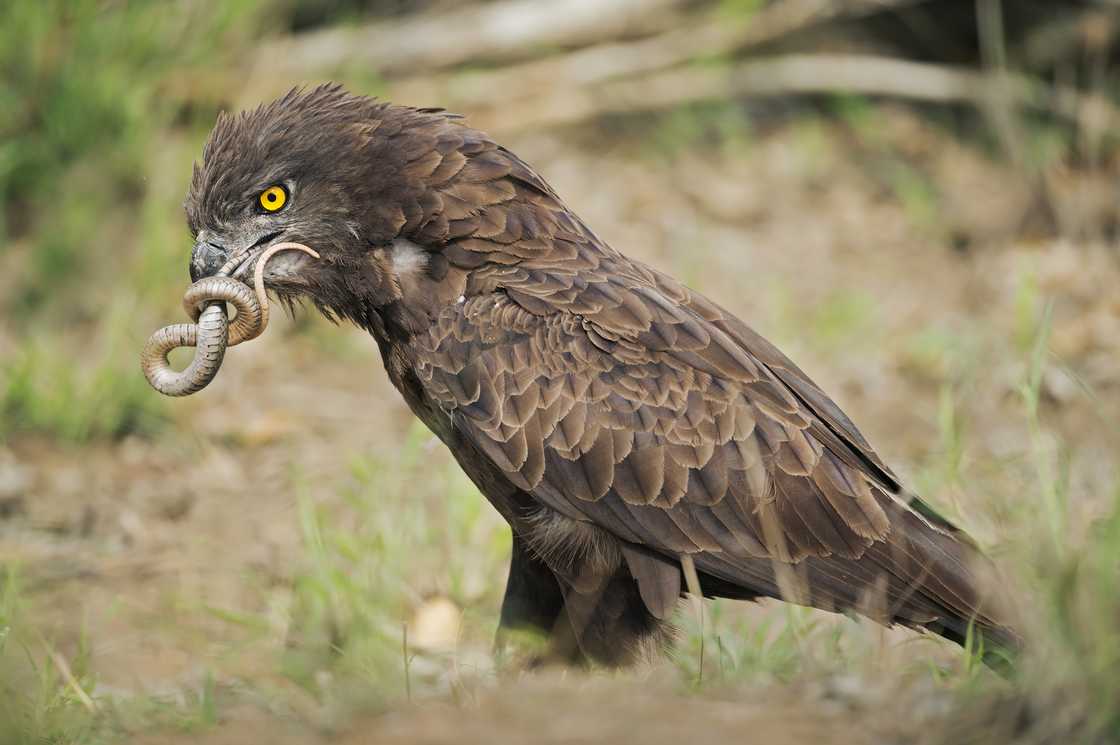What eats snakes? List of animals that hunt, eat, and prey on snakes
The feeding behaviour where animals specialise in hunting and consuming snakes is known as ophiophagy. Even though snakes are known to be dangerous, the Ophiophagus species play a crucial role in managing snake populations. By feeding on snakes, these animals help maintain a balanced ecosystem and preserve biodiversity. So, what eats snakes in the animal kingdom?

Source: Getty Images
TABLE OF CONTENTS
Snakes are classified as either secondary or tertiary consumers in the food chain based on the specific diet of each species. They may serve as prey for higher-level consumers, such as apex predators. Therefore, what eats snakes must be more advanced as a predator. Some of these animals have even developed resistance to snake venom, allowing them to prey on venomous snakes without the risk of death.
What eats snakes?
Snakes' venom can destroy the outer membrane of capillary vessels, causing internal bleeding. They are also feared for their swift movement, especially when attacked. However, with all this power, some animals feed on them daily. Below are some of the animals that feed on them if you are wondering, "What animals eat snakes?"
1. Wolverine

Source: Getty Images
- Average lifespan: 5–7 years (in the wild)
- Classification: Mammalia
- Origin: Canada and Alaska
Wolverine is one of the animals that eats snakes. This animal is fierce and strong for its size and can hunt prey much larger than itself. It eats various animals and is muscular and compact. It can climb trees and swim to catch its food. Besides hunting, it also scavenges for food, sometimes taking leftovers from other predators.
2. Racoons

Source: Getty Images
- Average lifespan: 3–5 years (in the wild)
- Classification : Mammalia
- Origin: United States, Canada, and Mexico
What eats garter snakes? Racoon is the answer to this question. A raccoon is a clever mammal known for its curiosity and agility. It often searches for food near water bodies and in wooded areas, where it can find various sources of sustenance. Despite being primarily omnivorous, it has a particular appetite for garter snakes.
3. Hedgehog

Source: Getty Images
- Average lifespan: 2–5 years (in the wild)
- Classification: Mammalia
- Origin: Africa, Asia, Europe and Scandinavia
This tiny creature is recognised for its resistance to different poisons. It can eat scorpions, spiders, beetles, frogs, bees, and snakes. It typically hunts at night, consuming about a third of its body weight. However, when food is scarce, it can go for long periods without eating.
4. Dolphins

Source: Getty Images
- Average lifespan: 40–60 years
- Classification: Mammalia
- Origin: The world's seas and oceans
Dolphins trained by the US Navy to detect mines were recorded hunting and consuming yellow-bellied sea snakes. These snakes are highly venomous and may even be poisonous if eaten. Despite this risk, one bottlenose dolphin consumed eight snakes without any apparent negative consequences.
5. Mongoose

Source: Getty Images
- Average lifespan: 10 years (in the wild)
- Classification: Mammalia
- Origin: Africa
Tiny and adorable, resembling cats, mongooses are nicknamed "cobra hitmen" for their intelligent hunting skills. While they pose no danger to humans, they're formidable foes for snakes. Agile and carnivorous, they defend themselves well and enjoy snake meat as a favourite meal.
6. Eagles

Source: Getty Images
- Average lifespan: 20–30 years
- Classification: Aves
- Origin: Eurasia and Africa
What eats snakes in the desert? Eagles, with their keen eyesight and powerful talons, are among the top predators of snakes in arid regions. These majestic birds of prey soar high above the desert landscape, scanning the ground for any movement. When they spot a snake, they swoop down fast, seizing their prey precisely.
7. Kingsnake

Source: Getty Images
- Average lifespan: 10–15 years (in the wild)
- Classification: Reptilia
- Origin: North America, United States and Mexico
Kingsnakes are also known to eat other snakes in the desert. These snakes hunt and eat other snakes, even venomous ones like rattlesnakes. They're immune to rattlesnake venom. They squeeze their prey to death. Some types of kingsnakes can squeeze twice as hard compared to their size as rat snakes and pythons. This helps them catch and kill snakes that can hold their breath longer.
8. Ground squirrels

Source: Getty Images
- Average lifespan: 3–4 years (in the wild)
- Classification: Mammalia
- Origin: Savannas, scrublands, rocky areas, and semi-desert environs
As tiny as they are, ground squirrels kill and eat snakes, especially the garter snakes. They're omnivores, which means they eat both plants and animals. Apart from snakes, they also eat nuts, fruits, seeds, insects, eggs, and small animals.
9. Red-tailed hawk

Source: Getty Images
- Average lifespan: 20 years
- Classification: Aves
- Origin: Alaska, Canada and south of Panama
Hawks are well-known for their fantastic eyesight, which lets them see prey from high up in the sky as they glide, carefully watching the ground below. Several types of hawks can hunt and kill snakes with their sharp claws and beaks, but the red-tailed hawk is particularly fond of them, making snakes a regular part of its hunting routine.
10. Honey badgers

Source: Getty Images
- Average lifespan: 24 years
- Classification: Mammalia
- Origin: Africa and Asia
Honey badgers have a diverse diet that includes various prey items, and snakes are among them. Honey badgers hunt and consume many snake species, including venomous snakes like cobras and vipers. They have tough skin and a fearless attitude that allows them to confront and devour snakes without much trouble.
11. Bobcat

Source: Getty Images
- Average lifespan: 12 years (in the wild)
- Classification: Mammalia
- Origin: United States and Southern Canada
Bobcats typically feed on a diet of rabbits, snakes, eggs, and lizards, but they can also hunt larger prey such as white-tailed deer and rattlesnakes. Their hunting styles vary depending on the size of their target. When targeting smaller animals, they seek areas rich in prey and wait patiently for their victims to approach before swiftly pouncing and seizing them with their claws.
12. Secretary birds

Source: Getty Images
- Average lifespan: 10–15 years (in the wild)
- Classification: Aves
- Origin: Sub-Saharan Africa
Secretary birds originate in Africa and are famous for their skill in defeating highly venomous snakes. They possess elongated legs for stomping on their prey and sharp claws for tearing apart the snake. They consume snakes, including various venomous types like puff adders, cobras, and other reptiles like lizards and small tortoises.
13. Owls

Source: Getty Images
- Average lifespan: 8–10 years (in the wild)
- Classification: Aves
- Origin: Everywhere in the world except Antarctica
These hunters primarily target small mammals. However, with over 225 owl species, their dietary habits vary. Not all owls prey on snakes, but at least five species, including the great horned owl, eastern screech owl, barred owl, burrowing owl, and long-eared owl, are known to include snakes in their diet.
14. King cobra

Source: Getty Images
- Average lifespan: 20 years (in the wild)
- Classification: Reptilia
- Origin: Northern India and east to southern China
The king cobra gets its name from its ability to kill and consume other cobras. A mature king cobra displays colours ranging from yellow, green, and brown to black, often with yellow-white crossbars or chevrons. It is one of the deadliest snakes in the world, feeding on other snakes. Like other cobras, it loves non-venomous snakes but will consume venomous ones when hungry.
15. Crocodile

Source: Getty Images
- Average lifespan: 50–60 years (Nile crocodiles), 70 years (saltwater)
- Classification: Reptilia
- Origin: Africa, Asia, and Australia
Crocodiles are very quick and sneaky when they attack, surprising their prey. Snakes don't stand a chance against their big, powerful jaws. When a crocodile bites a snake, it usually gets crushed and eaten in one go. The sad part is that snakes can't fight back because their fangs can't easily pierce the tough skin of a crocodile.
16. American badger

Source: Getty Images
- Average lifespan: 4–10 years (in the wild)
- Classification: Mammalia
- Origin: North America
Found widely across North America, these stout, short-legged creatures are part of the same family as otters, ferrets, weasels, and wolverines. While they sometimes consume grains and seeds as a last resort, American badgers are primarily carnivorous and readily devour snakes, mainly being notorious predators of rattlesnakes.
What eats snakes in the desert?
Among the creatures that eat desert snakes are hawks, owls, specific tarantulas, giant centipedes, roadrunners, badgers, skunks, foxes, and bobcats.
What eats garter snakes?
Crows, ravens, weasels, mink, raccoons, foxes, ground squirrels, skunks, hawks, and owls eat garter snakes. Garter snakes are a type of non-venomous snake found in North and Central America.
What are the predators of snakes?
Numerous species prey on snakes, including well-known birds of prey like eagle, owls, hawks, falcons, and herons. Bird species and fellow snakes are typically the primary predators of snakes, although plenty of mammals also hunt them.
What is the snake's greatest enemy?
The mongoose is known to be snakes' greatest enemy. It is fast enough to swiftly move in and bite the back of a dangerous snake before the snake can retaliate.
What animals are eaten by snakes?
Every snake is a carnivore. What they eat varies by species. Some feast on warm-blooded animals like rodents, rabbits, and birds, while others prefer insects, amphibians (like frogs or toads), eggs, fellow reptiles, fish, earthworms, or slugs.
What animal kills reptiles?
Birds are known for killing reptiles, but animals like cats also hunt and kill them. Despite their adorable appearance, the cats' natural hunting behaviour may contribute to declining reptile populations.
Understanding what eats snakes illuminates the intricate dynamics of ecosystems. Many animals, from birds and mammals to other snakes and reptiles, prey on snakes. This interplay between predators and prey is essential for maintaining natural balance and preserving biodiversity.
Yen.com.gh recently released an interesting list of the cutest animals in the world. There are millions of adorable and cuddly creatures in the world. These animals are intriguing, having distinctive characteristics and behaviours.
These creatures capture everyone's hearts, whether it's their adorable little faces, gorgeous fur, or cute behaviours. Read the post to learn about some of the world's most charming creatures.
Source: YEN.com.gh










